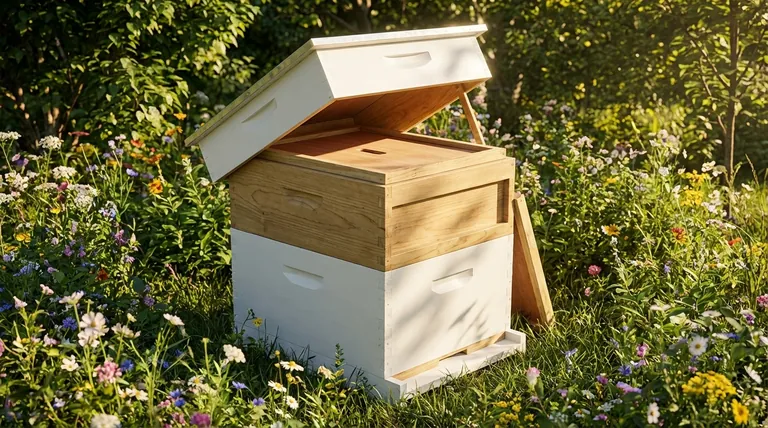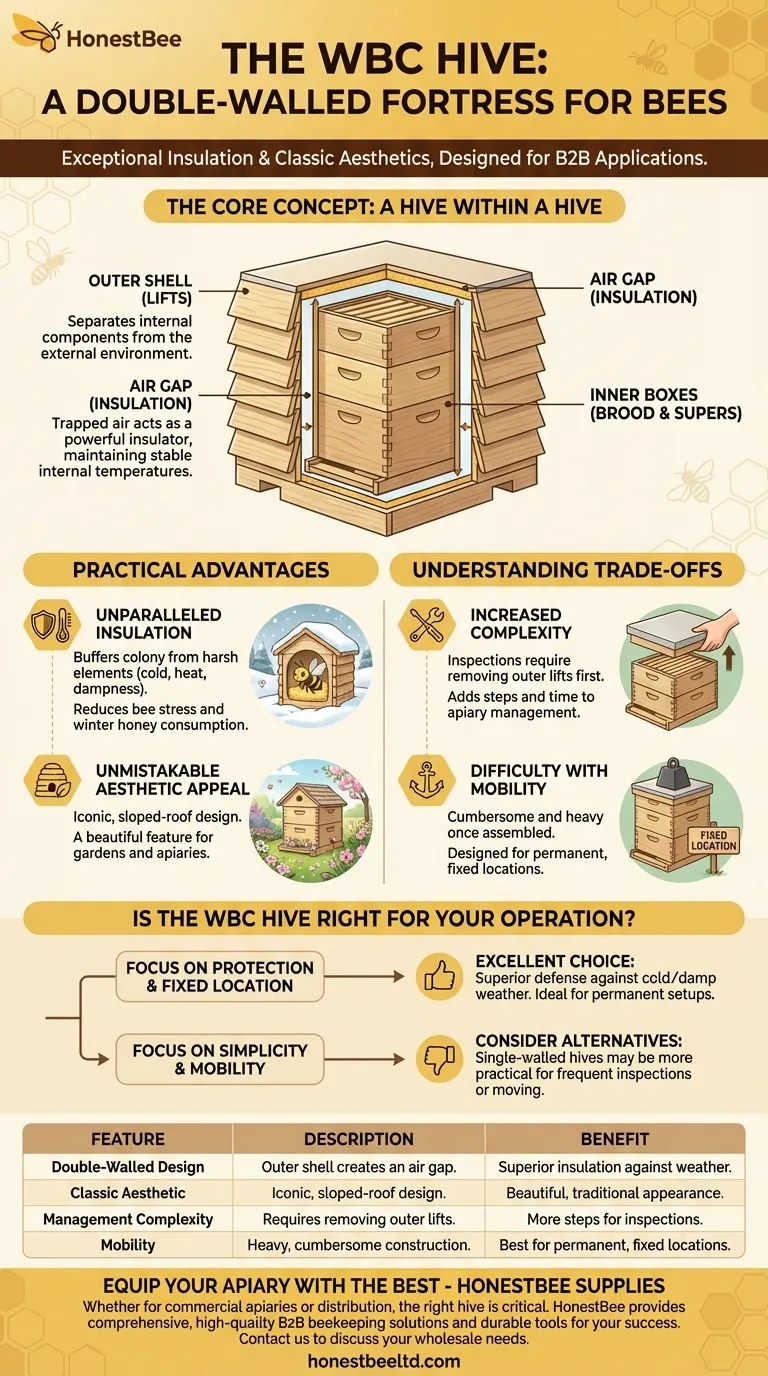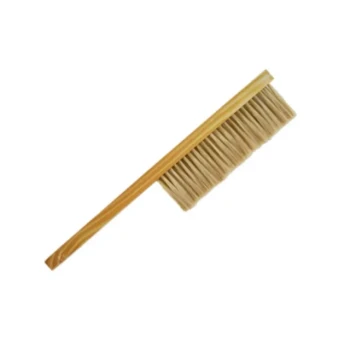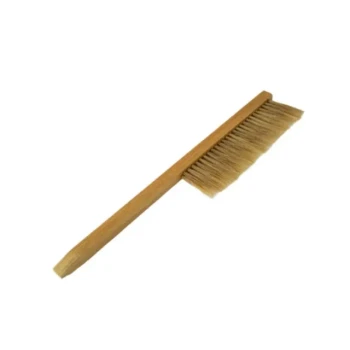At its core, the WBC Hive is a double-walled beehive known for its exceptional insulation and classic, picturesque appearance. Developed by William Broughton Carr and popular in the United Kingdom, its unique structure consists of an outer shell that protects separate, internal boxes, creating a pocket of air that shields the colony from cold and damp conditions.
The defining characteristic of the WBC Hive is its "hive within a hive" design. This prioritizes the colony's protection from harsh weather and offers a traditional aesthetic, but it comes at the cost of being more complex to manage and difficult to move compared to modern, single-walled hives.

The Core Concept: A Hive Within a Hive
The uniqueness of the WBC Hive, also known as the Classic Hive, is immediately apparent in its construction. Unlike more common single-walled designs, it separates the hive's internal components from its external shell.
The Double-Walled Structure
The hive is built with an outer casing, often called "lifts," which are stacked on top of each other. Inside these lifts sit the standard components of a beehive: the brood boxes and honey supers. This creates a significant air gap between the inner boxes and the outer wall.
The Purpose of the Air Gap
This trapped layer of air is the key to the WBC's design. It acts as a powerful insulator, much like the space between two panes of glass in a double-glazed window. This helps the bee colony maintain a more stable internal temperature year-round.
Enhanced Weather Protection
The insulation protects the bees from the harsh cold of winter and the extreme heat of summer. Critically, especially in damp climates like the UK's, it also helps keep the inner chambers dry, preventing issues with mold and disease.
The Practical Advantages of the WBC
Beekeepers choose the WBC Hive for two primary reasons that set it apart from other designs: superior protection and timeless beauty.
Unparalleled Insulation
By buffering the colony from the elements, the hive reduces stress on the bees. In winter, a well-insulated colony consumes fewer honey stores to generate heat, increasing its chances of survival.
Unmistakable Aesthetic Appeal
The WBC Hive is what many people picture when they think of a traditional beehive. Its classic, sloped-roof design is often depicted in historic paintings and illustrations, making it a beautiful and iconic feature in a garden or apiary.
Understanding the Trade-offs
While the design offers significant benefits, it also introduces complexities that a prospective beekeeper must consider.
Increased Complexity
Inspecting the colony requires more work. The beekeeper must first remove the outer lifts to gain access to the inner brood boxes or supers, adding an extra step to every inspection.
Difficulty with Mobility
The hive's construction, with its separate inner and outer parts, makes it very cumbersome. Once assembled and populated with a colony and honey, moving a WBC Hive is a difficult task best avoided. It is designed for a permanent location.
Is the WBC Hive Right for You?
Choosing a hive depends on balancing your climate, management style, and aesthetic goals.
- If your primary focus is providing the best possible insulation in a fixed location: The WBC Hive is an excellent choice, offering superior protection against cold and damp weather.
- If your primary focus is simplicity, frequent inspections, or the need to move your hives: A single-walled hive is likely a more practical option due to its lighter weight and more direct access to the colony.
Ultimately, the WBC Hive stands out for its commitment to colony protection and classic beauty, accepting a trade-off in operational convenience.
Summary Table:
| Feature | Description | Benefit |
|---|---|---|
| Double-Walled Design | An outer shell creates an air gap around the inner boxes. | Superior insulation, protecting bees from cold, heat, and dampness. |
| Classic Aesthetic | Iconic, sloped-roof design. | A beautiful, traditional feature for any garden or apiary. |
| Management Complexity | Requires removing outer lifts to access the colony. | More steps involved during hive inspections compared to single-walled hives. |
| Mobility | Heavy and cumbersome construction. | Best suited for a permanent, fixed location; difficult to move. |
Equip Your Apiary with the Best
Whether you manage a commercial apiary or are a distributor of beekeeping equipment, the right hive is critical for colony health and honey production. The WBC Hive is a prime example of specialized equipment designed for specific needs.
HONESTBEE supplies a comprehensive range of high-quality beekeeping supplies and equipment through our wholesale-focused operations. We provide the durable, reliable tools that commercial beekeepers and distributors depend on.
Ready to explore hive options and other essential supplies for your operation? Contact our team today to discuss your needs and discover how we can support your success with our wholesale solutions.
Visual Guide

Related Products
- Inner Beehive Cover for Beekeeping Bee Hive Inner Cover
- HONESTBEE Professional Long Handled Hive Tool with Precision Cutting Blade
- Professional Drop-Style Hive Handles for Beekeeping
- Professional Galvanized Hive Strap with Secure Locking Buckle for Beekeeping
- Professional Engraved Round Hive Number Tags for Beekeeping
People Also Ask
- How is the inner cover used to promote ventilation? Master Hive Climate Control for Healthy Bees
- Why might beekeepers use an inner cover under the telescoping outer cover? Simplify Hive Management & Protect Your Colony
- What are the advantages of using an inner cover in a beehive? Key Benefits for Hive Health & Beekeeper Efficiency
- What is the function of an inner cover in a beehive? Essential for Hive Health & Management
- What is the purpose of the inner cover in a beehive? A Key to Hive Health & Easy Management



















